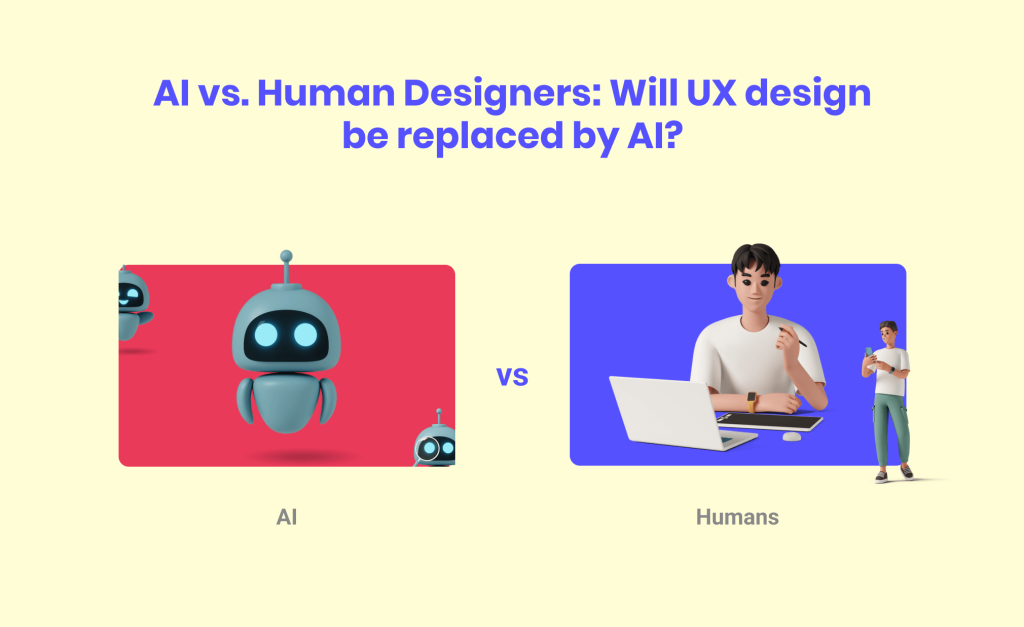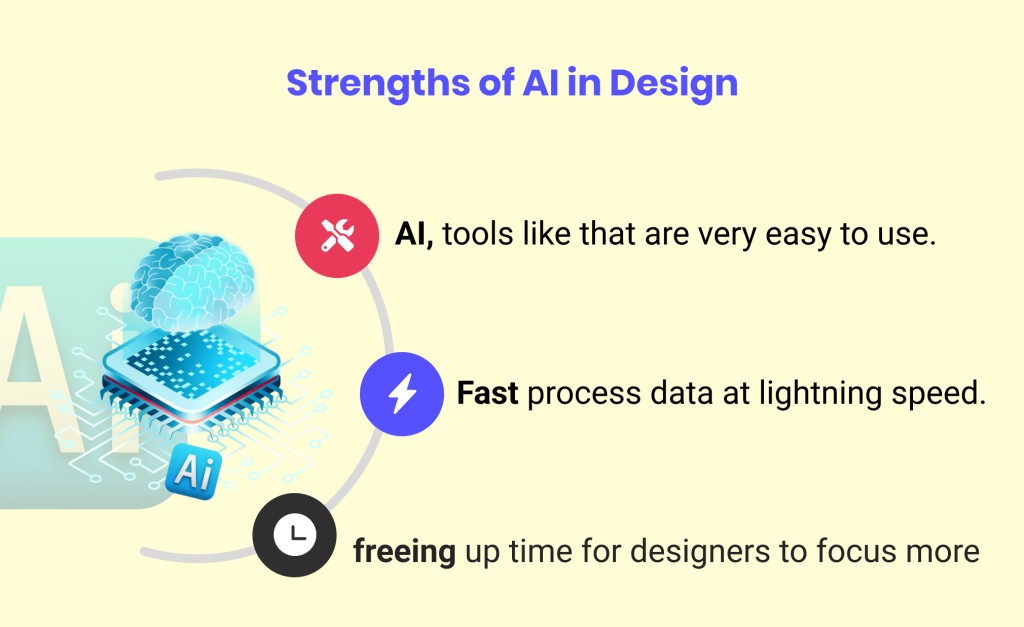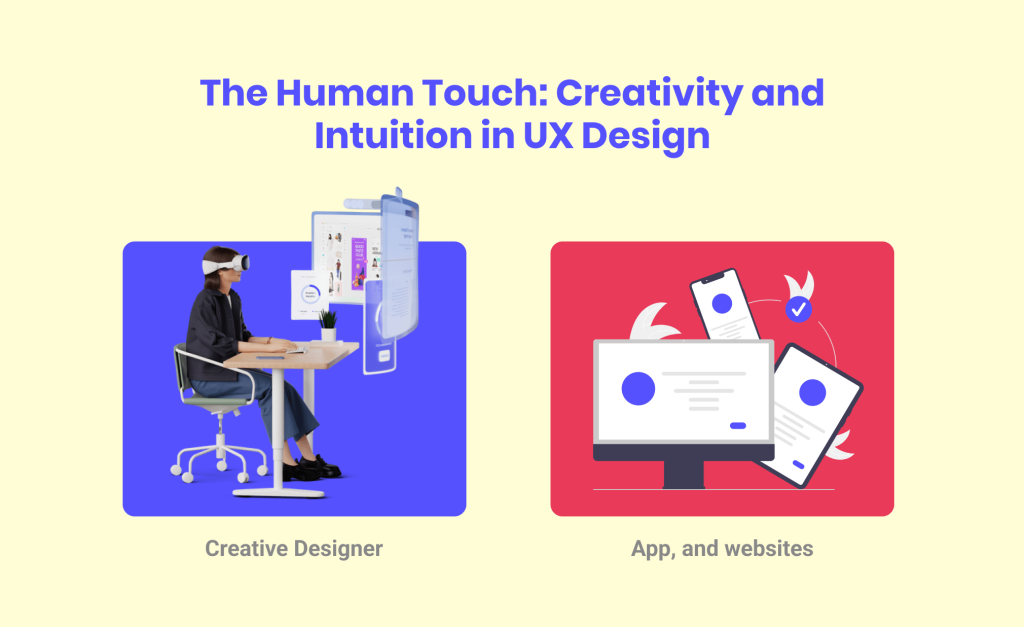In the rapidly changing landscape of technology, one question looms large, will AI eventually take over the realm of UX design? It’s a topic that sparks curiosity and debate among experts and enthusiasts alike. The immense development of AI also raises another question, “Will UX design be replaced by AI ?” Let’s explore the dimensions of artificial intelligence in the UX Design industry.
- UX Design
- AI vs. Human Designers: Will UX design be replaced by AI?
- The Human Touch: Creativity and Intuition in UX Design
- The Future Prospects of UX Design
- Ethical Considerations in AI-Driven Design
- Potential Career Implications for Aspiring Designers
- Conclusion
UX Design
Imagine navigating through your favorite app effortlessly, finding exactly what you need with just a few taps. That seamless experience is the result of meticulous UX design. UX, short for User Experience, focuses on creating products and systems that are user-friendly, intuitive, and delightful to interact with.
At its core, UX design revolves around understanding human behavior, needs, and preferences. It’s about empathizing with users to anticipate their actions and deliver solutions that exceed their expectations. This human-centered approach has been the driving force behind some of the most beloved digital experiences. Therefore, the essence of UX design can be considered as the understanding of human behavior and empathizing with users for making their experiences better. Now, consider the existing changes and evaluate the relationship between artificial intelligence and humans. What do you think? Is it a competitive battle or it’s a cooperative collaboration? Let’s unleash this together.
AI vs. Human Designers: Will UX design be replaced by AI?
AI has undoubtedly made significant strides in recent years, boasting capabilities that were once exclusive to human designers. From analyzing vast amounts of data to identifying patterns and trends, AI algorithms have showcased impressive prowess in various domains, including design. However, this process can be considered as enhancing the efficiency of humans. You can never consider that artificial intelligence is outplaying humans. There are several reasons behind it.

The core reason why AI is not being able to outplay humans in the design industry is empathic judgments. Artificial intelligence cannot create emotional bonding with users which always creates a gap in understanding human needs. AI can easily analyze millions of data and conclude a pattern of human behavior. The design based on the analysis of human behavior might seem very good. However, it cannot completely satisfy the needs of users. Since human minds work mysteriously and the emotional aspect is always prioritized by humans, it is never sufficient to provide a good design to them.
Users always want to feel special and prioritized by the design of every platform. Different types of individuals have different dopamine kick points. Identifying those points and working there is always a challenge for artificial intelligence. So, the human touch will always be required to make a design persuasive to a large number of users. Therefore, the question “Will UX design be replaced by AI” is still not alarming. If you analyze the core strengths and limitations of AI for design, you can come to a clearer conclusion. Let’s discuss those in the next section.
Strengths of AI in Design
One of the key strengths of AI lies in its ability to crunch numbers and process data at lightning speed. For UX designers, this translates into valuable insights gleaned from user behavior patterns, which can inform design decisions and optimizations. AI-powered tools also excel in tasks like automating repetitive design tasks, freeing up time for designers to focus on more creative endeavors.

Those are very useful for the basic research tasks of UX design. However, the major task of UX design is to create a judgment from those research and innovate designs that can solve the minor to major errors or inconveniences found in the research. AI is still not capable of doing that task properly because of the lack of emotion and creativity.
Artificial intelligence works based on a chunk of data with which it was trained and it might also learn from the inputs given to it. This limits its capability of innovation. Humans can think outside of the box and come up with a completely new dimension that was never explored or mentioned by anyone. This is where the core strength of AI also lags compared with human capability.
Limitations of AI in Understanding Human Emotions
AI still grapples with understanding the nuances of human emotions and contexts. While algorithms can analyze data and identify trends, they often fall short when it comes to interpreting the subtleties of human interaction. Emotions, cultural backgrounds, and individual preferences are complex layers that AI struggles to navigate, highlighting the irreplaceable role of human empathy in UX design.
AI is not able to trigger the emotional points of humans due to these limitations. As a result, users will never be able to feel a design completely or own something passionately that misses the human touch or contains a completely robotic tone. Let’s understand the concept of human touch and its role in creativity and intuition in UX design.
The Human Touch: Creativity and Intuition in UX Design
Beyond data analysis and problem-solving, human designers bring something unique to the table, creativity and intuition. The ability to think outside the box, experiment with novel ideas, and empathize with users on a deeper level is where human designers truly shine. It’s this human touch that infuses digital experiences with personality, emotion, and authenticity, forging meaningful connections with users.

Human experience can make an individual wise because he or she is not just processing the data and knowing about the details of an action rather that person is experiencing something which makes him or her face some consequences. As a result, the intuition power develops within that person. These diverse experiences can also come up with completely new and create ideas that can easily outplay the AI. So, to answer the question, “Will UX design be replaced by AI?”, it can be said that AI can only comprehend humans but will not be able to replace humans.
Potential Areas for Collaboration
Rather than viewing AI as a threat, many experts see it as a powerful ally in the realm of UX design. By leveraging AI’s strengths in data analysis and automation, human designers can amplify their creative capabilities and streamline their workflows. Imagine AI-powered tools that assist designers in generating design variations, conducting A/B testing, or predicting user preferences based on historical data. The possibilities for collaboration are endless, with AI serving as a catalyst for innovation rather than a substitute for human creativity.
The Future Prospects of UX Design
Looking ahead, the integration of AI into UX design holds immense potential for shaping the future of digital experiences. Predictive analytics, personalized recommendations, and adaptive interfaces are just a glimpse of what’s on the horizon. But along with the promises come ethical considerations and challenges that must be addressed.
Ethical Considerations in AI-Driven Design
As AI becomes more ingrained in UX design processes, questions around privacy, bias, and accountability come to the forefront. How do we ensure that AI algorithms make fair and unbiased decisions? What measures can be taken to protect user data and uphold ethical standards? These are pressing issues that demand careful consideration and proactive measures from designers and technologists alike.
Potential Career Implications for Aspiring Designers
For school-going teenagers aspiring to pursue a career in design, the emergence of AI presents both opportunities and challenges. While AI may automate certain tasks traditionally performed by designers, it also opens up new avenues for creativity and innovation. Skills like empathy, critical thinking, and adaptability will continue to be invaluable assets in the age of AI, guiding designers in navigating this ever-evolving landscape.
Conclusion
In the grand narrative of technology, the story of AI and UX design is still unfolding. While AI offers unprecedented capabilities in data analysis and automation, it’s the human touch that breathes life into digital experiences. As we venture into the future, let’s embrace AI as a partner in creativity, leveraging its strengths to augment our own. In the end, it’s the harmonious collaboration between man and machine that will truly revolutionize the way we design and interact with technology.
